BMP6004: Role of Organisational Learning in Improving Performance
VerifiedAdded on 2023/06/14
|11
|3426
|241
Essay
AI Summary
This essay critically analyzes the role of organisational learning in improving organisational performance, emphasizing its importance in adapting to changing business environments and fostering long-term success. It highlights how learning and development align employee goals with organizational objectives, bridging skill gaps through effective training strategies. The essay also explores the benefits of a strong organizational learning culture, including increased employee satisfaction, productivity, revenue generation, and adaptability to change. Furthermore, it examines organizational development methods, such as improving communication and project management, and analyzes learning models like Kolb's learning style model and the VARK model, discussing their applications and limitations in facilitating effective learning processes within organizations. The importance of strategic management and transparent business policies in fostering a successful learning environment is also underscored.
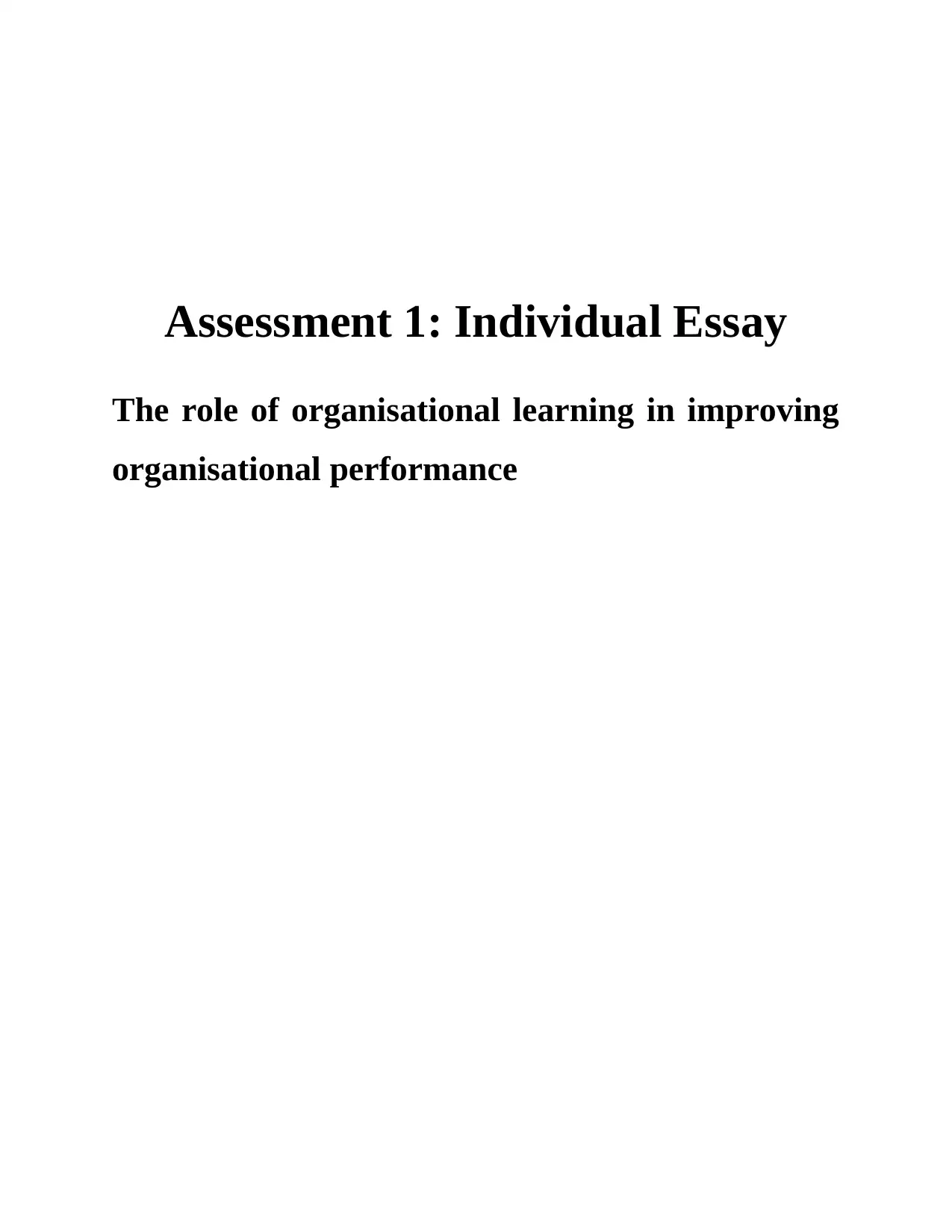
Assessment 1: Individual Essay
The role of organisational learning in improving
organisational performance
The role of organisational learning in improving
organisational performance
Paraphrase This Document
Need a fresh take? Get an instant paraphrase of this document with our AI Paraphraser

TABLE OF CONTENTS
REFERENCES................................................................................................................................9
REFERENCES................................................................................................................................9
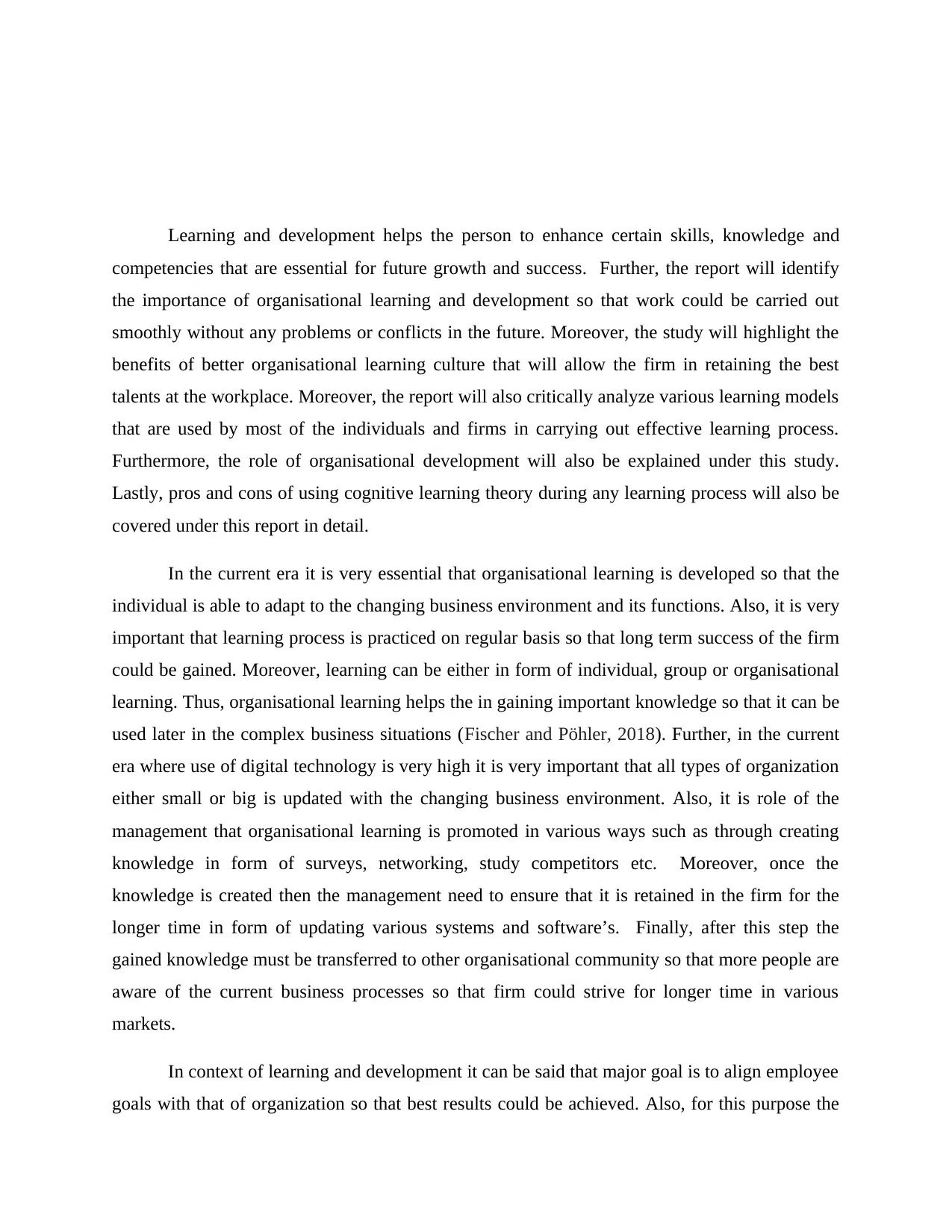
Learning and development helps the person to enhance certain skills, knowledge and
competencies that are essential for future growth and success. Further, the report will identify
the importance of organisational learning and development so that work could be carried out
smoothly without any problems or conflicts in the future. Moreover, the study will highlight the
benefits of better organisational learning culture that will allow the firm in retaining the best
talents at the workplace. Moreover, the report will also critically analyze various learning models
that are used by most of the individuals and firms in carrying out effective learning process.
Furthermore, the role of organisational development will also be explained under this study.
Lastly, pros and cons of using cognitive learning theory during any learning process will also be
covered under this report in detail.
In the current era it is very essential that organisational learning is developed so that the
individual is able to adapt to the changing business environment and its functions. Also, it is very
important that learning process is practiced on regular basis so that long term success of the firm
could be gained. Moreover, learning can be either in form of individual, group or organisational
learning. Thus, organisational learning helps the in gaining important knowledge so that it can be
used later in the complex business situations (Fischer and Pöhler, 2018). Further, in the current
era where use of digital technology is very high it is very important that all types of organization
either small or big is updated with the changing business environment. Also, it is role of the
management that organisational learning is promoted in various ways such as through creating
knowledge in form of surveys, networking, study competitors etc. Moreover, once the
knowledge is created then the management need to ensure that it is retained in the firm for the
longer time in form of updating various systems and software’s. Finally, after this step the
gained knowledge must be transferred to other organisational community so that more people are
aware of the current business processes so that firm could strive for longer time in various
markets.
In context of learning and development it can be said that major goal is to align employee
goals with that of organization so that best results could be achieved. Also, for this purpose the
competencies that are essential for future growth and success. Further, the report will identify
the importance of organisational learning and development so that work could be carried out
smoothly without any problems or conflicts in the future. Moreover, the study will highlight the
benefits of better organisational learning culture that will allow the firm in retaining the best
talents at the workplace. Moreover, the report will also critically analyze various learning models
that are used by most of the individuals and firms in carrying out effective learning process.
Furthermore, the role of organisational development will also be explained under this study.
Lastly, pros and cons of using cognitive learning theory during any learning process will also be
covered under this report in detail.
In the current era it is very essential that organisational learning is developed so that the
individual is able to adapt to the changing business environment and its functions. Also, it is very
important that learning process is practiced on regular basis so that long term success of the firm
could be gained. Moreover, learning can be either in form of individual, group or organisational
learning. Thus, organisational learning helps the in gaining important knowledge so that it can be
used later in the complex business situations (Fischer and Pöhler, 2018). Further, in the current
era where use of digital technology is very high it is very important that all types of organization
either small or big is updated with the changing business environment. Also, it is role of the
management that organisational learning is promoted in various ways such as through creating
knowledge in form of surveys, networking, study competitors etc. Moreover, once the
knowledge is created then the management need to ensure that it is retained in the firm for the
longer time in form of updating various systems and software’s. Finally, after this step the
gained knowledge must be transferred to other organisational community so that more people are
aware of the current business processes so that firm could strive for longer time in various
markets.
In context of learning and development it can be said that major goal is to align employee
goals with that of organization so that best results could be achieved. Also, for this purpose the
⊘ This is a preview!⊘
Do you want full access?
Subscribe today to unlock all pages.

Trusted by 1+ million students worldwide
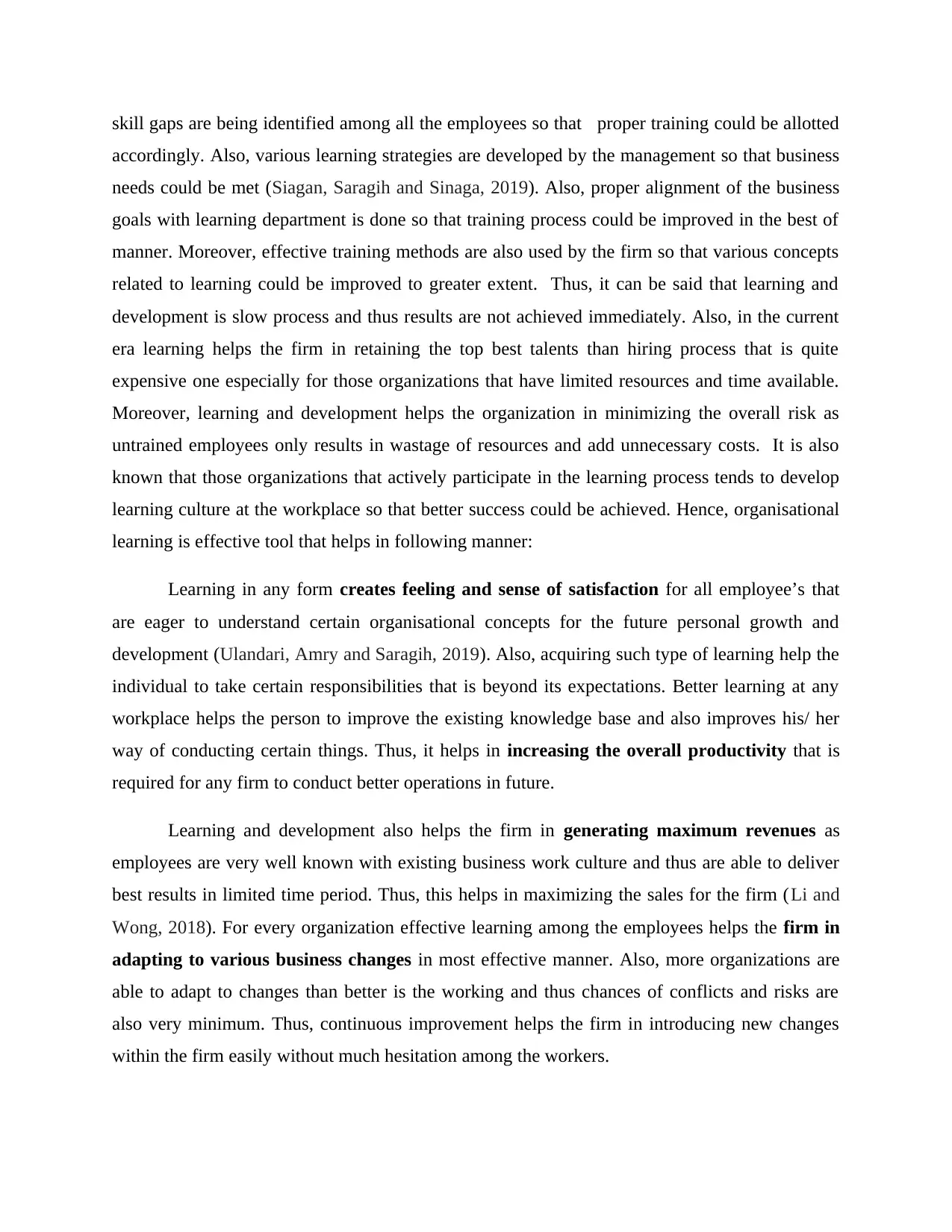
skill gaps are being identified among all the employees so that proper training could be allotted
accordingly. Also, various learning strategies are developed by the management so that business
needs could be met (Siagan, Saragih and Sinaga, 2019). Also, proper alignment of the business
goals with learning department is done so that training process could be improved in the best of
manner. Moreover, effective training methods are also used by the firm so that various concepts
related to learning could be improved to greater extent. Thus, it can be said that learning and
development is slow process and thus results are not achieved immediately. Also, in the current
era learning helps the firm in retaining the top best talents than hiring process that is quite
expensive one especially for those organizations that have limited resources and time available.
Moreover, learning and development helps the organization in minimizing the overall risk as
untrained employees only results in wastage of resources and add unnecessary costs. It is also
known that those organizations that actively participate in the learning process tends to develop
learning culture at the workplace so that better success could be achieved. Hence, organisational
learning is effective tool that helps in following manner:
Learning in any form creates feeling and sense of satisfaction for all employee’s that
are eager to understand certain organisational concepts for the future personal growth and
development (Ulandari, Amry and Saragih, 2019). Also, acquiring such type of learning help the
individual to take certain responsibilities that is beyond its expectations. Better learning at any
workplace helps the person to improve the existing knowledge base and also improves his/ her
way of conducting certain things. Thus, it helps in increasing the overall productivity that is
required for any firm to conduct better operations in future.
Learning and development also helps the firm in generating maximum revenues as
employees are very well known with existing business work culture and thus are able to deliver
best results in limited time period. Thus, this helps in maximizing the sales for the firm (Li and
Wong, 2018). For every organization effective learning among the employees helps the firm in
adapting to various business changes in most effective manner. Also, more organizations are
able to adapt to changes than better is the working and thus chances of conflicts and risks are
also very minimum. Thus, continuous improvement helps the firm in introducing new changes
within the firm easily without much hesitation among the workers.
accordingly. Also, various learning strategies are developed by the management so that business
needs could be met (Siagan, Saragih and Sinaga, 2019). Also, proper alignment of the business
goals with learning department is done so that training process could be improved in the best of
manner. Moreover, effective training methods are also used by the firm so that various concepts
related to learning could be improved to greater extent. Thus, it can be said that learning and
development is slow process and thus results are not achieved immediately. Also, in the current
era learning helps the firm in retaining the top best talents than hiring process that is quite
expensive one especially for those organizations that have limited resources and time available.
Moreover, learning and development helps the organization in minimizing the overall risk as
untrained employees only results in wastage of resources and add unnecessary costs. It is also
known that those organizations that actively participate in the learning process tends to develop
learning culture at the workplace so that better success could be achieved. Hence, organisational
learning is effective tool that helps in following manner:
Learning in any form creates feeling and sense of satisfaction for all employee’s that
are eager to understand certain organisational concepts for the future personal growth and
development (Ulandari, Amry and Saragih, 2019). Also, acquiring such type of learning help the
individual to take certain responsibilities that is beyond its expectations. Better learning at any
workplace helps the person to improve the existing knowledge base and also improves his/ her
way of conducting certain things. Thus, it helps in increasing the overall productivity that is
required for any firm to conduct better operations in future.
Learning and development also helps the firm in generating maximum revenues as
employees are very well known with existing business work culture and thus are able to deliver
best results in limited time period. Thus, this helps in maximizing the sales for the firm (Li and
Wong, 2018). For every organization effective learning among the employees helps the firm in
adapting to various business changes in most effective manner. Also, more organizations are
able to adapt to changes than better is the working and thus chances of conflicts and risks are
also very minimum. Thus, continuous improvement helps the firm in introducing new changes
within the firm easily without much hesitation among the workers.
Paraphrase This Document
Need a fresh take? Get an instant paraphrase of this document with our AI Paraphraser
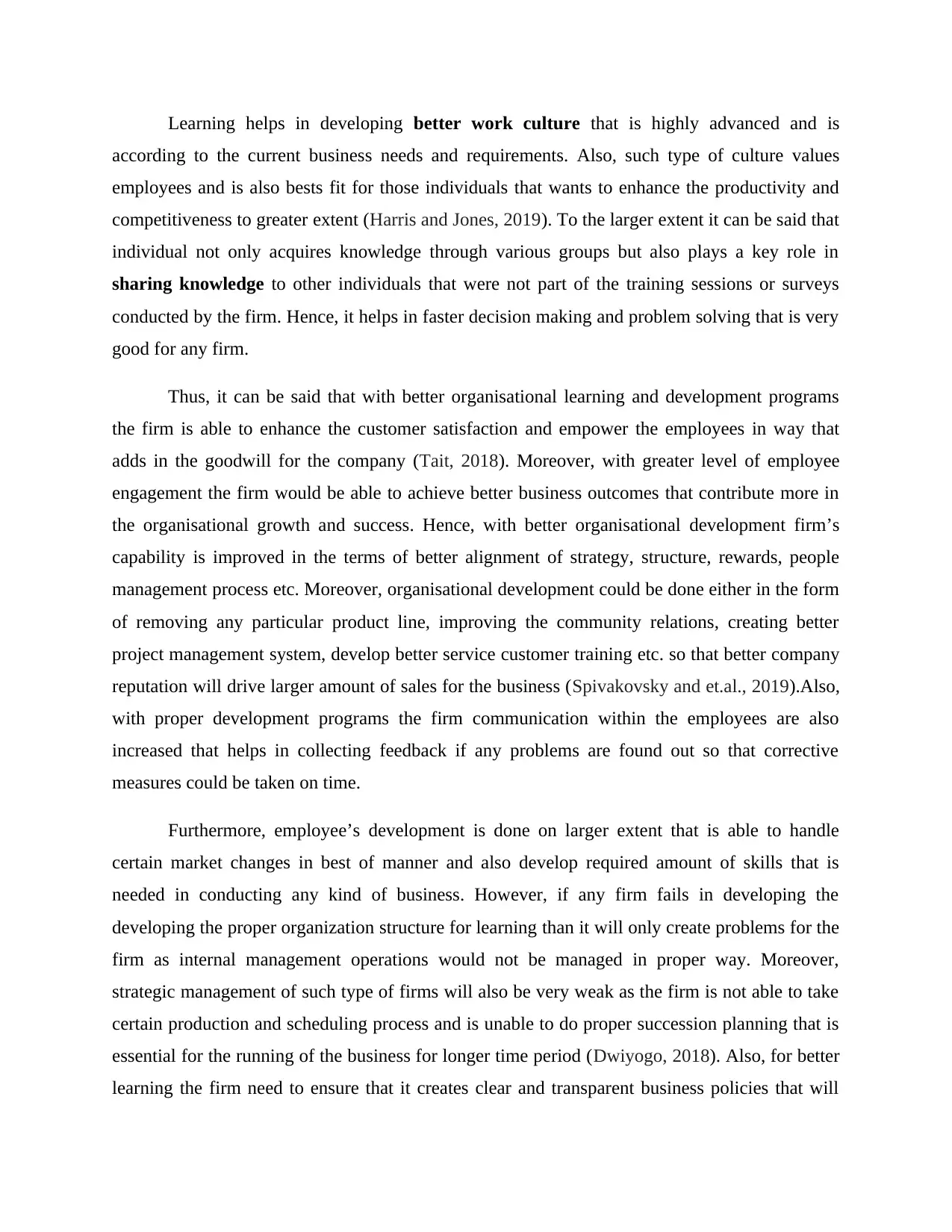
Learning helps in developing better work culture that is highly advanced and is
according to the current business needs and requirements. Also, such type of culture values
employees and is also bests fit for those individuals that wants to enhance the productivity and
competitiveness to greater extent (Harris and Jones, 2019). To the larger extent it can be said that
individual not only acquires knowledge through various groups but also plays a key role in
sharing knowledge to other individuals that were not part of the training sessions or surveys
conducted by the firm. Hence, it helps in faster decision making and problem solving that is very
good for any firm.
Thus, it can be said that with better organisational learning and development programs
the firm is able to enhance the customer satisfaction and empower the employees in way that
adds in the goodwill for the company (Tait, 2018). Moreover, with greater level of employee
engagement the firm would be able to achieve better business outcomes that contribute more in
the organisational growth and success. Hence, with better organisational development firm’s
capability is improved in the terms of better alignment of strategy, structure, rewards, people
management process etc. Moreover, organisational development could be done either in the form
of removing any particular product line, improving the community relations, creating better
project management system, develop better service customer training etc. so that better company
reputation will drive larger amount of sales for the business (Spivakovsky and et.al., 2019).Also,
with proper development programs the firm communication within the employees are also
increased that helps in collecting feedback if any problems are found out so that corrective
measures could be taken on time.
Furthermore, employee’s development is done on larger extent that is able to handle
certain market changes in best of manner and also develop required amount of skills that is
needed in conducting any kind of business. However, if any firm fails in developing the
developing the proper organization structure for learning than it will only create problems for the
firm as internal management operations would not be managed in proper way. Moreover,
strategic management of such type of firms will also be very weak as the firm is not able to take
certain production and scheduling process and is unable to do proper succession planning that is
essential for the running of the business for longer time period (Dwiyogo, 2018). Also, for better
learning the firm need to ensure that it creates clear and transparent business policies that will
according to the current business needs and requirements. Also, such type of culture values
employees and is also bests fit for those individuals that wants to enhance the productivity and
competitiveness to greater extent (Harris and Jones, 2019). To the larger extent it can be said that
individual not only acquires knowledge through various groups but also plays a key role in
sharing knowledge to other individuals that were not part of the training sessions or surveys
conducted by the firm. Hence, it helps in faster decision making and problem solving that is very
good for any firm.
Thus, it can be said that with better organisational learning and development programs
the firm is able to enhance the customer satisfaction and empower the employees in way that
adds in the goodwill for the company (Tait, 2018). Moreover, with greater level of employee
engagement the firm would be able to achieve better business outcomes that contribute more in
the organisational growth and success. Hence, with better organisational development firm’s
capability is improved in the terms of better alignment of strategy, structure, rewards, people
management process etc. Moreover, organisational development could be done either in the form
of removing any particular product line, improving the community relations, creating better
project management system, develop better service customer training etc. so that better company
reputation will drive larger amount of sales for the business (Spivakovsky and et.al., 2019).Also,
with proper development programs the firm communication within the employees are also
increased that helps in collecting feedback if any problems are found out so that corrective
measures could be taken on time.
Furthermore, employee’s development is done on larger extent that is able to handle
certain market changes in best of manner and also develop required amount of skills that is
needed in conducting any kind of business. However, if any firm fails in developing the
developing the proper organization structure for learning than it will only create problems for the
firm as internal management operations would not be managed in proper way. Moreover,
strategic management of such type of firms will also be very weak as the firm is not able to take
certain production and scheduling process and is unable to do proper succession planning that is
essential for the running of the business for longer time period (Dwiyogo, 2018). Also, for better
learning the firm need to ensure that it creates clear and transparent business policies that will
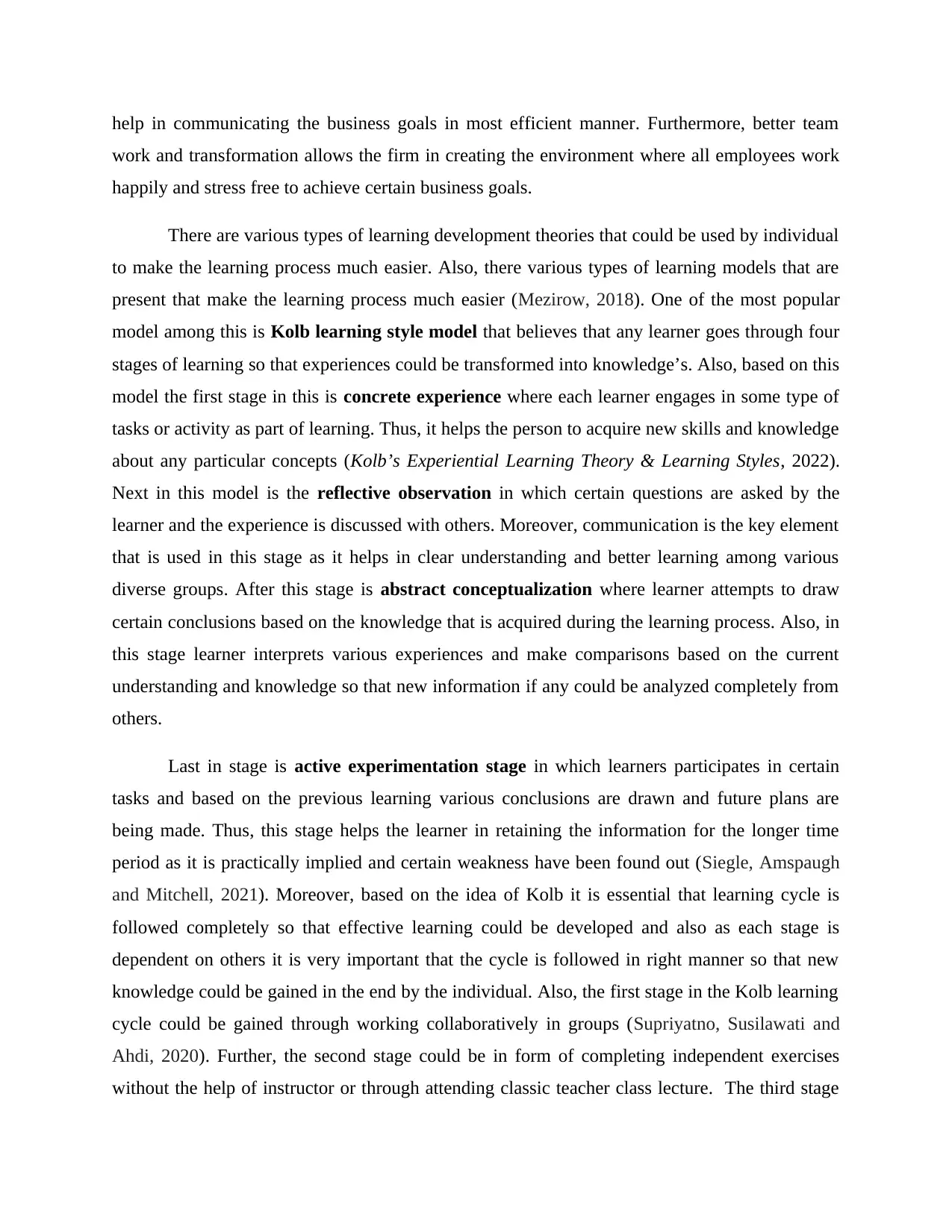
help in communicating the business goals in most efficient manner. Furthermore, better team
work and transformation allows the firm in creating the environment where all employees work
happily and stress free to achieve certain business goals.
There are various types of learning development theories that could be used by individual
to make the learning process much easier. Also, there various types of learning models that are
present that make the learning process much easier (Mezirow, 2018). One of the most popular
model among this is Kolb learning style model that believes that any learner goes through four
stages of learning so that experiences could be transformed into knowledge’s. Also, based on this
model the first stage in this is concrete experience where each learner engages in some type of
tasks or activity as part of learning. Thus, it helps the person to acquire new skills and knowledge
about any particular concepts (Kolb’s Experiential Learning Theory & Learning Styles, 2022).
Next in this model is the reflective observation in which certain questions are asked by the
learner and the experience is discussed with others. Moreover, communication is the key element
that is used in this stage as it helps in clear understanding and better learning among various
diverse groups. After this stage is abstract conceptualization where learner attempts to draw
certain conclusions based on the knowledge that is acquired during the learning process. Also, in
this stage learner interprets various experiences and make comparisons based on the current
understanding and knowledge so that new information if any could be analyzed completely from
others.
Last in stage is active experimentation stage in which learners participates in certain
tasks and based on the previous learning various conclusions are drawn and future plans are
being made. Thus, this stage helps the learner in retaining the information for the longer time
period as it is practically implied and certain weakness have been found out (Siegle, Amspaugh
and Mitchell, 2021). Moreover, based on the idea of Kolb it is essential that learning cycle is
followed completely so that effective learning could be developed and also as each stage is
dependent on others it is very important that the cycle is followed in right manner so that new
knowledge could be gained in the end by the individual. Also, the first stage in the Kolb learning
cycle could be gained through working collaboratively in groups (Supriyatno, Susilawati and
Ahdi, 2020). Further, the second stage could be in form of completing independent exercises
without the help of instructor or through attending classic teacher class lecture. The third stage
work and transformation allows the firm in creating the environment where all employees work
happily and stress free to achieve certain business goals.
There are various types of learning development theories that could be used by individual
to make the learning process much easier. Also, there various types of learning models that are
present that make the learning process much easier (Mezirow, 2018). One of the most popular
model among this is Kolb learning style model that believes that any learner goes through four
stages of learning so that experiences could be transformed into knowledge’s. Also, based on this
model the first stage in this is concrete experience where each learner engages in some type of
tasks or activity as part of learning. Thus, it helps the person to acquire new skills and knowledge
about any particular concepts (Kolb’s Experiential Learning Theory & Learning Styles, 2022).
Next in this model is the reflective observation in which certain questions are asked by the
learner and the experience is discussed with others. Moreover, communication is the key element
that is used in this stage as it helps in clear understanding and better learning among various
diverse groups. After this stage is abstract conceptualization where learner attempts to draw
certain conclusions based on the knowledge that is acquired during the learning process. Also, in
this stage learner interprets various experiences and make comparisons based on the current
understanding and knowledge so that new information if any could be analyzed completely from
others.
Last in stage is active experimentation stage in which learners participates in certain
tasks and based on the previous learning various conclusions are drawn and future plans are
being made. Thus, this stage helps the learner in retaining the information for the longer time
period as it is practically implied and certain weakness have been found out (Siegle, Amspaugh
and Mitchell, 2021). Moreover, based on the idea of Kolb it is essential that learning cycle is
followed completely so that effective learning could be developed and also as each stage is
dependent on others it is very important that the cycle is followed in right manner so that new
knowledge could be gained in the end by the individual. Also, the first stage in the Kolb learning
cycle could be gained through working collaboratively in groups (Supriyatno, Susilawati and
Ahdi, 2020). Further, the second stage could be in form of completing independent exercises
without the help of instructor or through attending classic teacher class lecture. The third stage
⊘ This is a preview!⊘
Do you want full access?
Subscribe today to unlock all pages.

Trusted by 1+ million students worldwide
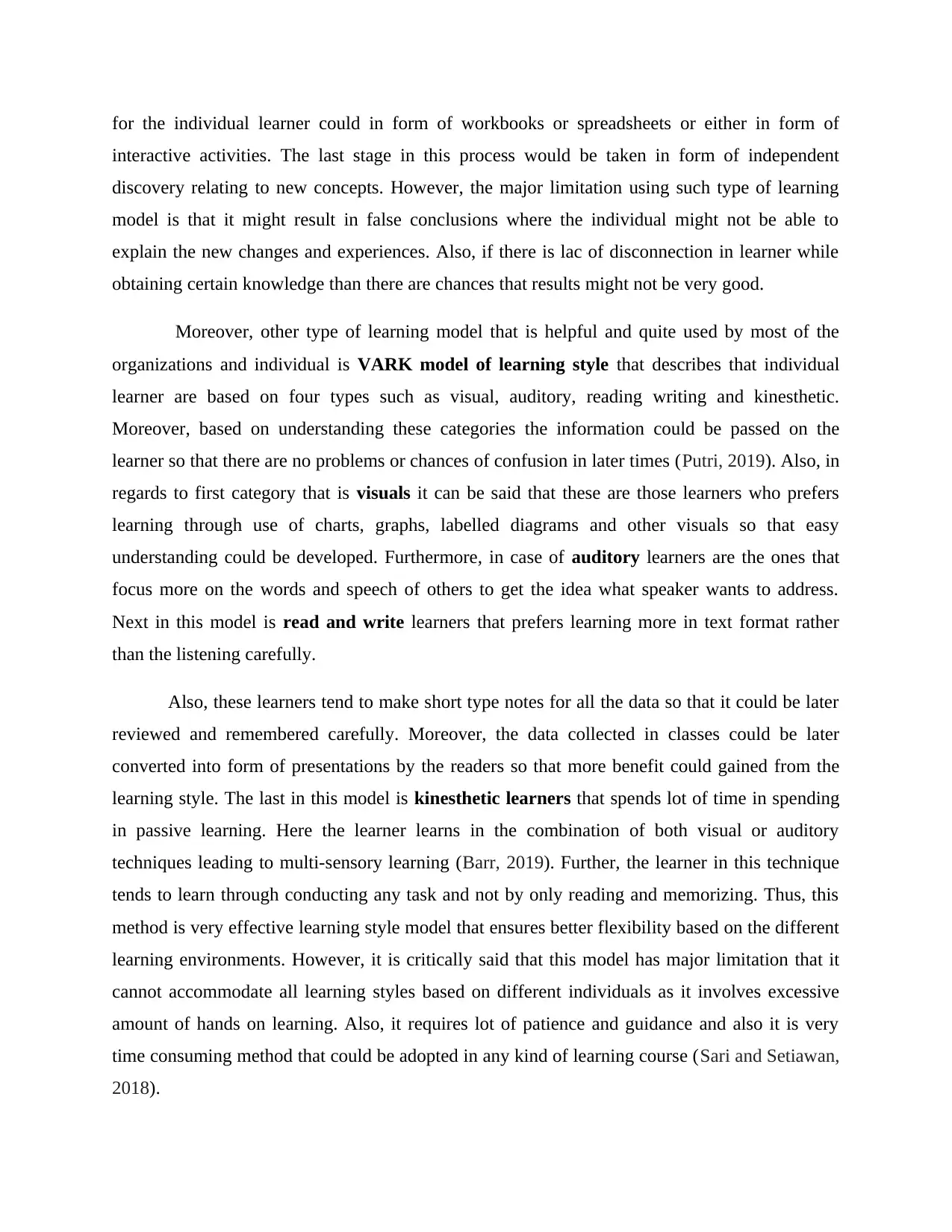
for the individual learner could in form of workbooks or spreadsheets or either in form of
interactive activities. The last stage in this process would be taken in form of independent
discovery relating to new concepts. However, the major limitation using such type of learning
model is that it might result in false conclusions where the individual might not be able to
explain the new changes and experiences. Also, if there is lac of disconnection in learner while
obtaining certain knowledge than there are chances that results might not be very good.
Moreover, other type of learning model that is helpful and quite used by most of the
organizations and individual is VARK model of learning style that describes that individual
learner are based on four types such as visual, auditory, reading writing and kinesthetic.
Moreover, based on understanding these categories the information could be passed on the
learner so that there are no problems or chances of confusion in later times (Putri, 2019). Also, in
regards to first category that is visuals it can be said that these are those learners who prefers
learning through use of charts, graphs, labelled diagrams and other visuals so that easy
understanding could be developed. Furthermore, in case of auditory learners are the ones that
focus more on the words and speech of others to get the idea what speaker wants to address.
Next in this model is read and write learners that prefers learning more in text format rather
than the listening carefully.
Also, these learners tend to make short type notes for all the data so that it could be later
reviewed and remembered carefully. Moreover, the data collected in classes could be later
converted into form of presentations by the readers so that more benefit could gained from the
learning style. The last in this model is kinesthetic learners that spends lot of time in spending
in passive learning. Here the learner learns in the combination of both visual or auditory
techniques leading to multi-sensory learning (Barr, 2019). Further, the learner in this technique
tends to learn through conducting any task and not by only reading and memorizing. Thus, this
method is very effective learning style model that ensures better flexibility based on the different
learning environments. However, it is critically said that this model has major limitation that it
cannot accommodate all learning styles based on different individuals as it involves excessive
amount of hands on learning. Also, it requires lot of patience and guidance and also it is very
time consuming method that could be adopted in any kind of learning course (Sari and Setiawan,
2018).
interactive activities. The last stage in this process would be taken in form of independent
discovery relating to new concepts. However, the major limitation using such type of learning
model is that it might result in false conclusions where the individual might not be able to
explain the new changes and experiences. Also, if there is lac of disconnection in learner while
obtaining certain knowledge than there are chances that results might not be very good.
Moreover, other type of learning model that is helpful and quite used by most of the
organizations and individual is VARK model of learning style that describes that individual
learner are based on four types such as visual, auditory, reading writing and kinesthetic.
Moreover, based on understanding these categories the information could be passed on the
learner so that there are no problems or chances of confusion in later times (Putri, 2019). Also, in
regards to first category that is visuals it can be said that these are those learners who prefers
learning through use of charts, graphs, labelled diagrams and other visuals so that easy
understanding could be developed. Furthermore, in case of auditory learners are the ones that
focus more on the words and speech of others to get the idea what speaker wants to address.
Next in this model is read and write learners that prefers learning more in text format rather
than the listening carefully.
Also, these learners tend to make short type notes for all the data so that it could be later
reviewed and remembered carefully. Moreover, the data collected in classes could be later
converted into form of presentations by the readers so that more benefit could gained from the
learning style. The last in this model is kinesthetic learners that spends lot of time in spending
in passive learning. Here the learner learns in the combination of both visual or auditory
techniques leading to multi-sensory learning (Barr, 2019). Further, the learner in this technique
tends to learn through conducting any task and not by only reading and memorizing. Thus, this
method is very effective learning style model that ensures better flexibility based on the different
learning environments. However, it is critically said that this model has major limitation that it
cannot accommodate all learning styles based on different individuals as it involves excessive
amount of hands on learning. Also, it requires lot of patience and guidance and also it is very
time consuming method that could be adopted in any kind of learning course (Sari and Setiawan,
2018).
Paraphrase This Document
Need a fresh take? Get an instant paraphrase of this document with our AI Paraphraser
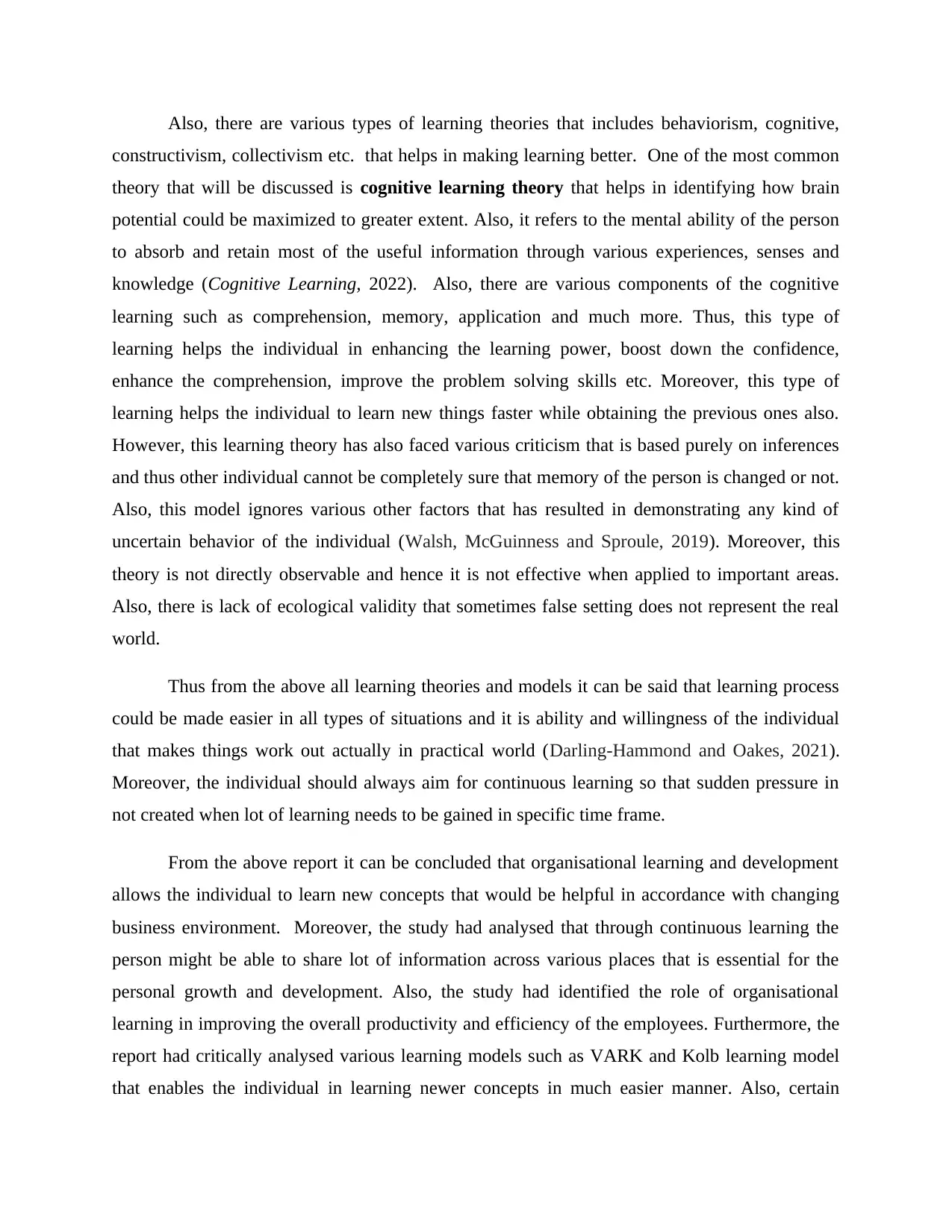
Also, there are various types of learning theories that includes behaviorism, cognitive,
constructivism, collectivism etc. that helps in making learning better. One of the most common
theory that will be discussed is cognitive learning theory that helps in identifying how brain
potential could be maximized to greater extent. Also, it refers to the mental ability of the person
to absorb and retain most of the useful information through various experiences, senses and
knowledge (Cognitive Learning, 2022). Also, there are various components of the cognitive
learning such as comprehension, memory, application and much more. Thus, this type of
learning helps the individual in enhancing the learning power, boost down the confidence,
enhance the comprehension, improve the problem solving skills etc. Moreover, this type of
learning helps the individual to learn new things faster while obtaining the previous ones also.
However, this learning theory has also faced various criticism that is based purely on inferences
and thus other individual cannot be completely sure that memory of the person is changed or not.
Also, this model ignores various other factors that has resulted in demonstrating any kind of
uncertain behavior of the individual (Walsh, McGuinness and Sproule, 2019). Moreover, this
theory is not directly observable and hence it is not effective when applied to important areas.
Also, there is lack of ecological validity that sometimes false setting does not represent the real
world.
Thus from the above all learning theories and models it can be said that learning process
could be made easier in all types of situations and it is ability and willingness of the individual
that makes things work out actually in practical world (Darling-Hammond and Oakes, 2021).
Moreover, the individual should always aim for continuous learning so that sudden pressure in
not created when lot of learning needs to be gained in specific time frame.
From the above report it can be concluded that organisational learning and development
allows the individual to learn new concepts that would be helpful in accordance with changing
business environment. Moreover, the study had analysed that through continuous learning the
person might be able to share lot of information across various places that is essential for the
personal growth and development. Also, the study had identified the role of organisational
learning in improving the overall productivity and efficiency of the employees. Furthermore, the
report had critically analysed various learning models such as VARK and Kolb learning model
that enables the individual in learning newer concepts in much easier manner. Also, certain
constructivism, collectivism etc. that helps in making learning better. One of the most common
theory that will be discussed is cognitive learning theory that helps in identifying how brain
potential could be maximized to greater extent. Also, it refers to the mental ability of the person
to absorb and retain most of the useful information through various experiences, senses and
knowledge (Cognitive Learning, 2022). Also, there are various components of the cognitive
learning such as comprehension, memory, application and much more. Thus, this type of
learning helps the individual in enhancing the learning power, boost down the confidence,
enhance the comprehension, improve the problem solving skills etc. Moreover, this type of
learning helps the individual to learn new things faster while obtaining the previous ones also.
However, this learning theory has also faced various criticism that is based purely on inferences
and thus other individual cannot be completely sure that memory of the person is changed or not.
Also, this model ignores various other factors that has resulted in demonstrating any kind of
uncertain behavior of the individual (Walsh, McGuinness and Sproule, 2019). Moreover, this
theory is not directly observable and hence it is not effective when applied to important areas.
Also, there is lack of ecological validity that sometimes false setting does not represent the real
world.
Thus from the above all learning theories and models it can be said that learning process
could be made easier in all types of situations and it is ability and willingness of the individual
that makes things work out actually in practical world (Darling-Hammond and Oakes, 2021).
Moreover, the individual should always aim for continuous learning so that sudden pressure in
not created when lot of learning needs to be gained in specific time frame.
From the above report it can be concluded that organisational learning and development
allows the individual to learn new concepts that would be helpful in accordance with changing
business environment. Moreover, the study had analysed that through continuous learning the
person might be able to share lot of information across various places that is essential for the
personal growth and development. Also, the study had identified the role of organisational
learning in improving the overall productivity and efficiency of the employees. Furthermore, the
report had critically analysed various learning models such as VARK and Kolb learning model
that enables the individual in learning newer concepts in much easier manner. Also, certain
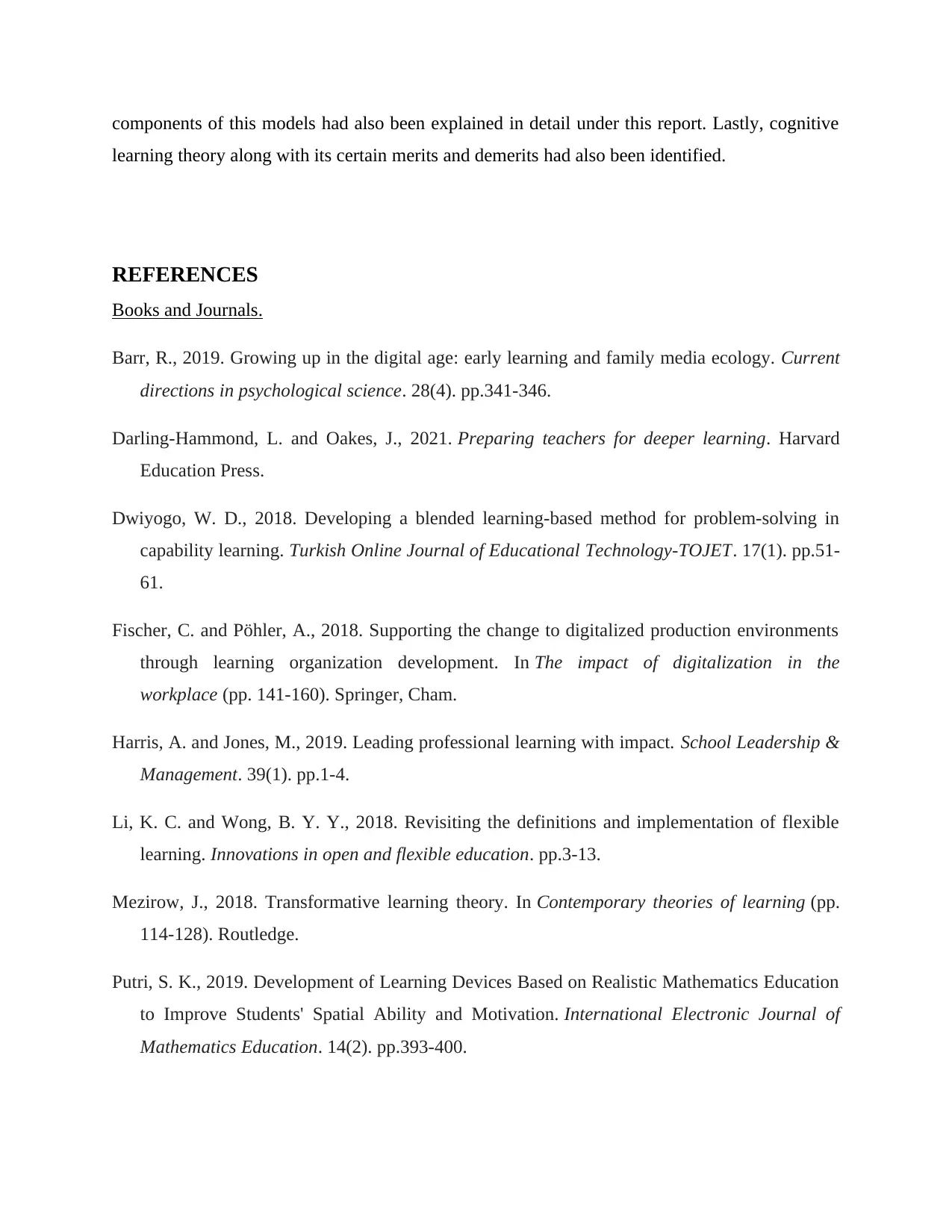
components of this models had also been explained in detail under this report. Lastly, cognitive
learning theory along with its certain merits and demerits had also been identified.
REFERENCES
Books and Journals.
Barr, R., 2019. Growing up in the digital age: early learning and family media ecology. Current
directions in psychological science. 28(4). pp.341-346.
Darling-Hammond, L. and Oakes, J., 2021. Preparing teachers for deeper learning. Harvard
Education Press.
Dwiyogo, W. D., 2018. Developing a blended learning-based method for problem-solving in
capability learning. Turkish Online Journal of Educational Technology-TOJET. 17(1). pp.51-
61.
Fischer, C. and Pöhler, A., 2018. Supporting the change to digitalized production environments
through learning organization development. In The impact of digitalization in the
workplace (pp. 141-160). Springer, Cham.
Harris, A. and Jones, M., 2019. Leading professional learning with impact. School Leadership &
Management. 39(1). pp.1-4.
Li, K. C. and Wong, B. Y. Y., 2018. Revisiting the definitions and implementation of flexible
learning. Innovations in open and flexible education. pp.3-13.
Mezirow, J., 2018. Transformative learning theory. In Contemporary theories of learning (pp.
114-128). Routledge.
Putri, S. K., 2019. Development of Learning Devices Based on Realistic Mathematics Education
to Improve Students' Spatial Ability and Motivation. International Electronic Journal of
Mathematics Education. 14(2). pp.393-400.
learning theory along with its certain merits and demerits had also been identified.
REFERENCES
Books and Journals.
Barr, R., 2019. Growing up in the digital age: early learning and family media ecology. Current
directions in psychological science. 28(4). pp.341-346.
Darling-Hammond, L. and Oakes, J., 2021. Preparing teachers for deeper learning. Harvard
Education Press.
Dwiyogo, W. D., 2018. Developing a blended learning-based method for problem-solving in
capability learning. Turkish Online Journal of Educational Technology-TOJET. 17(1). pp.51-
61.
Fischer, C. and Pöhler, A., 2018. Supporting the change to digitalized production environments
through learning organization development. In The impact of digitalization in the
workplace (pp. 141-160). Springer, Cham.
Harris, A. and Jones, M., 2019. Leading professional learning with impact. School Leadership &
Management. 39(1). pp.1-4.
Li, K. C. and Wong, B. Y. Y., 2018. Revisiting the definitions and implementation of flexible
learning. Innovations in open and flexible education. pp.3-13.
Mezirow, J., 2018. Transformative learning theory. In Contemporary theories of learning (pp.
114-128). Routledge.
Putri, S. K., 2019. Development of Learning Devices Based on Realistic Mathematics Education
to Improve Students' Spatial Ability and Motivation. International Electronic Journal of
Mathematics Education. 14(2). pp.393-400.
⊘ This is a preview!⊘
Do you want full access?
Subscribe today to unlock all pages.

Trusted by 1+ million students worldwide
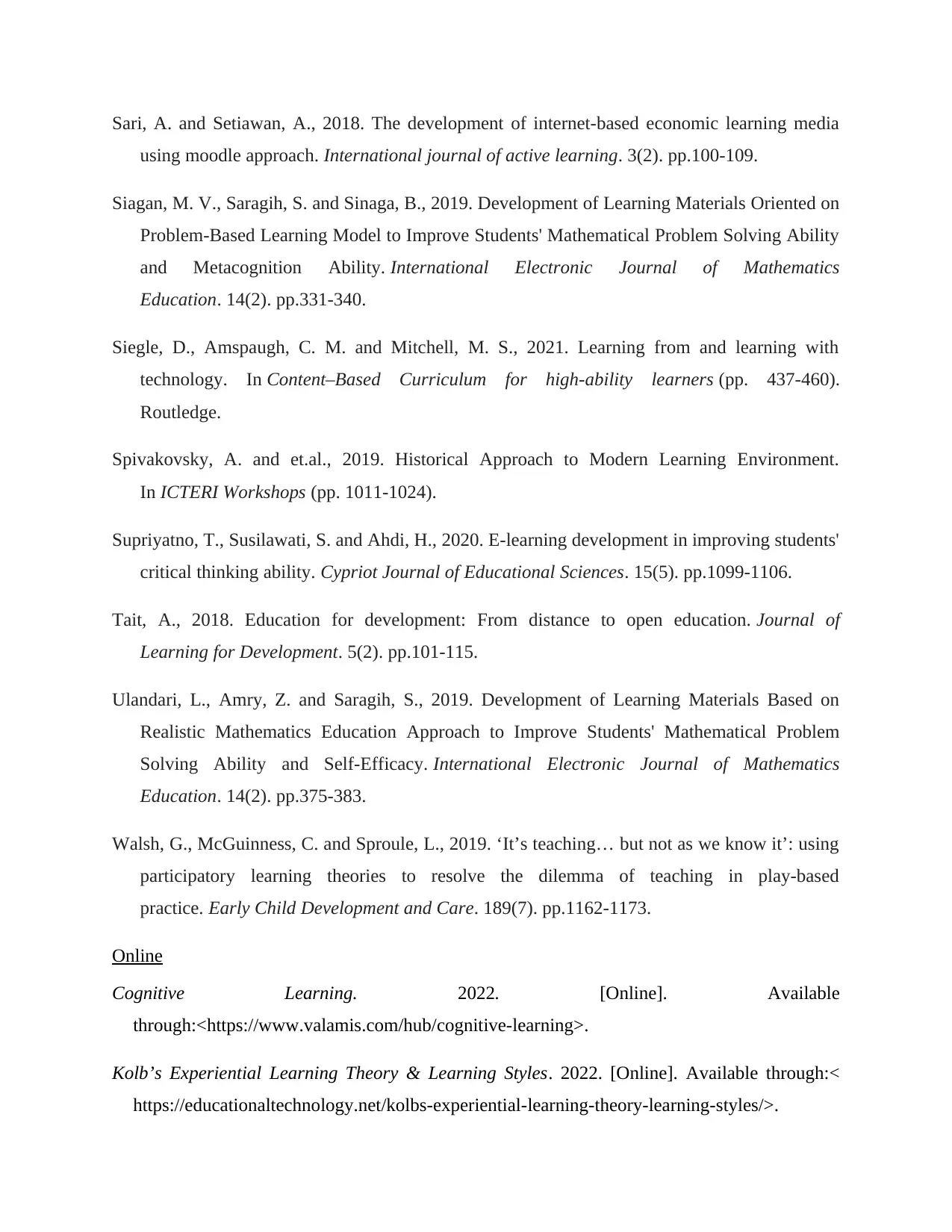
Sari, A. and Setiawan, A., 2018. The development of internet-based economic learning media
using moodle approach. International journal of active learning. 3(2). pp.100-109.
Siagan, M. V., Saragih, S. and Sinaga, B., 2019. Development of Learning Materials Oriented on
Problem-Based Learning Model to Improve Students' Mathematical Problem Solving Ability
and Metacognition Ability. International Electronic Journal of Mathematics
Education. 14(2). pp.331-340.
Siegle, D., Amspaugh, C. M. and Mitchell, M. S., 2021. Learning from and learning with
technology. In Content–Based Curriculum for high-ability learners (pp. 437-460).
Routledge.
Spivakovsky, A. and et.al., 2019. Historical Approach to Modern Learning Environment.
In ICTERI Workshops (pp. 1011-1024).
Supriyatno, T., Susilawati, S. and Ahdi, H., 2020. E-learning development in improving students'
critical thinking ability. Cypriot Journal of Educational Sciences. 15(5). pp.1099-1106.
Tait, A., 2018. Education for development: From distance to open education. Journal of
Learning for Development. 5(2). pp.101-115.
Ulandari, L., Amry, Z. and Saragih, S., 2019. Development of Learning Materials Based on
Realistic Mathematics Education Approach to Improve Students' Mathematical Problem
Solving Ability and Self-Efficacy. International Electronic Journal of Mathematics
Education. 14(2). pp.375-383.
Walsh, G., McGuinness, C. and Sproule, L., 2019. ‘It’s teaching… but not as we know it’: using
participatory learning theories to resolve the dilemma of teaching in play-based
practice. Early Child Development and Care. 189(7). pp.1162-1173.
Online
Cognitive Learning. 2022. [Online]. Available
through:<https://www.valamis.com/hub/cognitive-learning>.
Kolb’s Experiential Learning Theory & Learning Styles. 2022. [Online]. Available through:<
https://educationaltechnology.net/kolbs-experiential-learning-theory-learning-styles/>.
using moodle approach. International journal of active learning. 3(2). pp.100-109.
Siagan, M. V., Saragih, S. and Sinaga, B., 2019. Development of Learning Materials Oriented on
Problem-Based Learning Model to Improve Students' Mathematical Problem Solving Ability
and Metacognition Ability. International Electronic Journal of Mathematics
Education. 14(2). pp.331-340.
Siegle, D., Amspaugh, C. M. and Mitchell, M. S., 2021. Learning from and learning with
technology. In Content–Based Curriculum for high-ability learners (pp. 437-460).
Routledge.
Spivakovsky, A. and et.al., 2019. Historical Approach to Modern Learning Environment.
In ICTERI Workshops (pp. 1011-1024).
Supriyatno, T., Susilawati, S. and Ahdi, H., 2020. E-learning development in improving students'
critical thinking ability. Cypriot Journal of Educational Sciences. 15(5). pp.1099-1106.
Tait, A., 2018. Education for development: From distance to open education. Journal of
Learning for Development. 5(2). pp.101-115.
Ulandari, L., Amry, Z. and Saragih, S., 2019. Development of Learning Materials Based on
Realistic Mathematics Education Approach to Improve Students' Mathematical Problem
Solving Ability and Self-Efficacy. International Electronic Journal of Mathematics
Education. 14(2). pp.375-383.
Walsh, G., McGuinness, C. and Sproule, L., 2019. ‘It’s teaching… but not as we know it’: using
participatory learning theories to resolve the dilemma of teaching in play-based
practice. Early Child Development and Care. 189(7). pp.1162-1173.
Online
Cognitive Learning. 2022. [Online]. Available
through:<https://www.valamis.com/hub/cognitive-learning>.
Kolb’s Experiential Learning Theory & Learning Styles. 2022. [Online]. Available through:<
https://educationaltechnology.net/kolbs-experiential-learning-theory-learning-styles/>.
Paraphrase This Document
Need a fresh take? Get an instant paraphrase of this document with our AI Paraphraser

1 out of 11
Related Documents
Your All-in-One AI-Powered Toolkit for Academic Success.
+13062052269
info@desklib.com
Available 24*7 on WhatsApp / Email
![[object Object]](/_next/static/media/star-bottom.7253800d.svg)
Unlock your academic potential
Copyright © 2020–2025 A2Z Services. All Rights Reserved. Developed and managed by ZUCOL.




